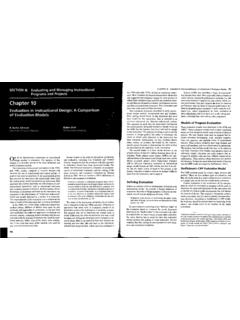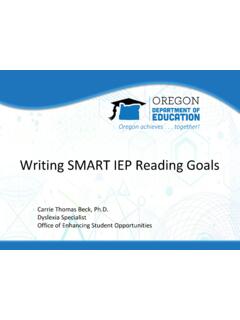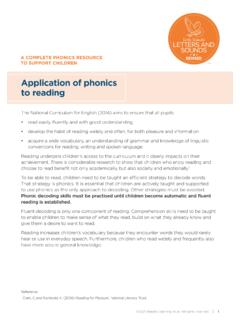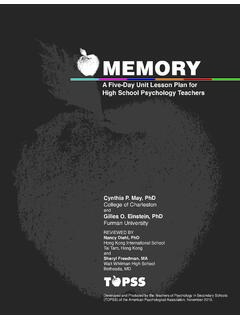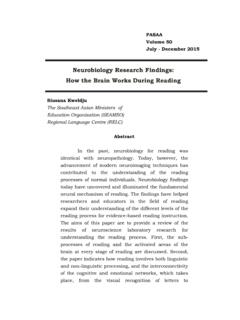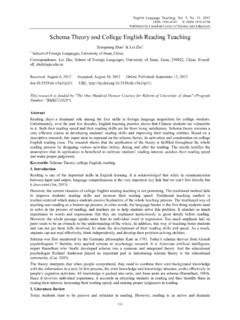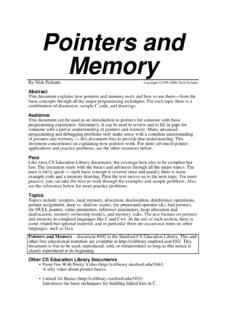Transcription of WORKING MEMORY
1 'andGrahamHitch'UNIVERSITYOFSTIRLING,STI RLING, } ,TransfertoLTS, }' decadeofintensiveresearchonthetopicofsho rt-termmemory(STM), ,ofcourse, (STS)-thehypotheticalmemorysystemwhichis assumedtoberesponsibleforperformanceinta sksinvolvingshort-termmemoryparadigms(At kinson&Shiffrin,1968)-hasbeenas-signeda crucialroleintheperformanceofawiderangeo ftasksincludingproblemsolving(Hunter,196 4),languagecomprehension(Rumelhart,Linds ay,&Norman,1972)andmostnotably,long-term learning(Atkinson&Shiffrin,1968;Waugh&No rman,1965).Per-hapsthemostcogentcasefort hecentralimportanceofSTSingen-eralinform ationprocessingisthatofAtkinsonandShiffr in(1971) ,despitethefrequencywithwhichSTS1 , 'Vorkin~Melllor}'49hasbeenassignedthisro leasanoperationalorworkingmemory,theempi ricalevidenceforsucha 'sgeneralprocessingca-pacity,asreRectedb yhisperformanceonsomesimultaneoussub-sid iarytask,suchascardsorting(Murdock,1965) ,trackingper-formance(Martin,1970),orrea ctiontimeOohnston,Griffith&Wagstaff,1972 ).
2 However, (1972)attemptedtostudytheroleofSTSinconc eptformationbymeansoftheacousticsimilari tyeffect,thetendencyforSTMtobedisruptedw henthematerialtoberemem-beredcomprisesit emsthatarephonemicallysimilartoeachother (Baddeley,1966b;Conrad,1962).Shecontrast edtheeffectofacousticsimilarityonconcept formationwiththatofsemanticsimilarity,wh ichtypicallyeffectsLTMratherthanSTM(Badd eley,1966a).Unfortunatelyfortheworkingme moryhypothesis,herresultsshowedclearevid enceofsemanticratherthanacousticcoding,s ug-gestingthatthelong-termstore(LTS) (1971)testedthehypothesisthatSTSplaysthe impor-tantroleinretrievalofholdingtheret rievalplan,whichisthenusedtoaccessthemat erialtoberecalled(Rumelhartetai.)
3 ,1972). (1959), , (Shallice&Warrington,1970;Warrington&Sha llice,1969;Warrington&'""eiskrantz,1972) .Theyhaveextensivelystudiedapatientwhoby allnormalstandards,hasa , ,thenonewouldexpectthispatienttoexhibitg rosslydefectivelearning, MEMORY , (Warrington,Logue,&Pratt,1971).Itappears then,thatSTSconstitutesasystemforwhichgr eatclaimshavebeenmadebymanyworkers(inclu dingthepresentauthors), tions:first,isthereanyevidencethatthetas ksofreasoning,com prehension,andlearningsharea commonworkingmemorysystem?; systemexists,howisitrelatedtoOUfcurrentc onceptionofSTM?'""edonotclaimtobepresent inga ,ouraimistopresentabodyofnewexperimental evidencewhichprovidesa , ,however,thatthereaderwillagreethatwedoh aveenoughinformationtodrawsomereasonably firmconclusions,andwillfeelthatareportof workinprogressisnottoooutofplaceina ,languagecomprehension, , , ,orperhapsbecauseof, ,suchresearchwouldneverbegin.
4 , ~)andGrah'lIltHitchWorking~ [MEANTIME(SEC) :EffectsofaOne orTwo ItemPreloadblSUbje~ (activeorpassive)affirmation(affirmative ornegative),truthvalue(trueorfalse)ve:bt ecedesorfollows),andletterorder(ABBA)Th' . yp(pre aversf isgivenoneortwoItems~ "True"or"False"IPhsthesen torecallthI'' tences,eachofwhichremainedvisibleuntilSp resPsedthe"T"or"False"krueThdresponse ~chthethreeconditionswerepresentedwerede ~ermmeyaLatmsque , ,Swasalwayspresentedwitha singleletterbeforee ,"astheonaIIt .IdS.' samethnas, eone andtwo letterloads,thelettersdifferedfromtrial~ otrialA~~Swerenevefrthesameasthoseusedin thereasoningproblems (Baddeley,1968)anditssensitivitytobothen viron mentalandspeed loadstress(BaddeleyDF'dCurtis&William196 8.]
5 'eIgure0,Hawkswell fi'.s,..'; Brown,Tickner,&Simmonds,1969).Ther~\7~ ,one, 'ona , (\968) ,andS' ,hemaybegiventhesentenceAisnotprecededby B AB, ,positiveornegative,andwhetherthewordl, widerangeofsentenceverificationtasksstud iedinrecentyears(Wason& ,1972). \VORKINGi\rEi\10 RYINREASONING tentionoforderinformation, ;however,itsotherdominantfeatureisitsapp arentreosistencetotheeffectsofothervaria bles,whetherselnanticorspeech based(Glanzer,1972).Ratherthantrytoresol vetheseapparentdiscrepancies,wedecidedto beginbystudyingtheonecharacteristicthatb othapproachestoSTSagTeedon, ,languagecomprehension, concurrentmemoryloadmightreasonablybeexp ectedtoabsorbsomeofthestoragecapacityofa limitedcapacityworkingmemorysystem, reasoningtask:-Toanticipateourresults,we finda con sistentpatternofadditionalmemoryloadeffe ctsonallthreetasksthatwehavestudied:reas oning,languagecomprehension, ,allthreetasksshowevidenceofphonemiccod , ,incon trasttothemoreusualviewthatbothrecencyan dthememoryspan-reRecta singlelimitedcapacityshort termbufferstore(STS).
6 <:hWorkingMemory53 MEANREASONINGTIMESANDRECALLScORESFORTHE"EQUALSTRESS"AND"MEMORYSTRESS"INSTRUCTIONALGROUPSr-Ieanreasoningtimes(forcorrectsolutions) "equalstress"Ssmemoryloadproduceda slightbutnonsignificantslowingdowninreasoningtime(onaWilcoxontest,T=31,N=12,P>.05),whileforthe"memorystress"Ssmemorylo adsloweddownreason-ingconsiderably(T=4,N =12,P<.01).Thereappearstohavebeena , thesesuggestthattheinter-actiondependson thestorageloadsince, "memorystress"Ssdealtwiththememorypreloa dbyquicklyrehearsingtheitems,to"consoll- date" ,thenreasoningtimesoughttobeslowedbya constantamount(thetimespentrehearsingthe letters), (RTs)showthatproblemsexpressedaspassives weremoredifficultthanthoseexpressedasact ives, , (max=6) (sec)ControlInstructionalemphasis"Equals tress""I\1emorystress" verbal"ready" , , ,thereasoningproblemfollowedimmediatelya fterthe"ready"sig ,andbeforebeingpresentedwiththenextprobl em,Slistenedtoa , , (equalstress)
7 Wastoldtocarryoutthereasoningtaskasrapid lyaspossible,consistentwithhighaccuracy, (memorystress)wastoldthatonlyiftheirreca llwascompletelycorrectcouldtheirreasonin gtimebescored;subjecttothisproviso,theyw eretoldtoreasonasrapidlyastheycould, minutepracticesessiononasheetofreasoning problems, ,andwaspresentedvisuallyorauditorily(F<I ineachcase).Sinceletterrecallwasalmostal waysperfect, ;eitherthatthetypeofmemorysysteminvolved inre-tainingthelettersisnotrelevanttothe reasoningtask,orelsethata , \VorkingMemoryGRAMMATICALFORMOFREASONING PROBLEMO'-;~:';:-:':-:""'::--'-:'! "memorystress" (sec)errorsConcul'rentarticulationContro l"The-The-The. ' " :EffectsofaGonCl/rrenti1 IemoryLoadAll5sperformedthe32reasoningpr oblemsundereachoffourconditions, verbalwarningsignalandtheinstruction"say nothing.
8 " (1967).Subjectswereinstructedtosaythewor d"the" ,whereuponhecontinuedthearticulationtask atthesamehighrateuntilhehadpressedthe"Tr ue"or"False" (1969)inwhichthearticulationtaskconsiste dofthecyclicrepetitionofafamiliarsequenc eofresponses,namelythecountingsequence"o ne-two-three-four five-six."Again,a ,5 , , "the"andcountinguptosixproducedaslightsl owingofreasoningtime, significantmaineffectofMEA:-;REASONINGTa tESANDERRORRATESASAFUNCTIONOFCoNCURRENTA RTICULATORYACTIVITYTABLEIIIoCONTROL[lj6- 01 GITMEMORYLOAD5008v>uJLOO:>:~~300zo~200w' "z~100:>:ofmemoryload[F( )= <.025].sentencevoice[F( :P<.025].andnegation[F( <.00l]. ( ;Murray,1967,1968)andreason-mg(Hammerton ,1969; ), ' fcrcntl)' [F( )= <.)]]
9 01).' (Wason& ).passivesentencesprovedmoredifficulttha nactivesentences[F( )= <.01],andnegativesweremoredifficultthana ffirmatives[F(I,II)= ,P<.01). :PhonemicSimilarityandVerbalReasoningOne ofthemorestrikingfeaturesofthememoryspan forverbalmaterialsisitsapparentrelianceo nphonemic(eitheracousticorarticulatory) (Conrad,1962;Sperling,1963)andbytheimpai rmentinper-formanceshownwhensequencesofp honemicallysimilaritemsarerecalled(Badde ley,1966b;Conrad&Hull,1964).AsWickelgren (1965)hasshown,phonemicsimilarityhasitsd isruptiveeffectprin-currentactivity,acti vityinteractedwithsentencevoice[F(3,33) <.01)andwithnegativity[F( )= ,P<.01). , ,ithasbeenshownthatadditionalSTMloadsofm orethantwoitemscanimpairtherateatwhichre asoningiscar ,buttheeffectmaydependontheinstructional emphasisgiventoSs(ExperimentII).]]]
10 Theinterferenceeffectsmaybepartlyduetoth earticulatoryactivityassociatedwithrehea rsalofthememoryitems,butthereisa substantialamountofinterferenceoverandab ovethiswhichispresumablyduetostorageload (ExperimentIII).Thetrade-offbetweenreaso ningspeedandadditionalstorageloadsug-ges tsthattheinterferenceoccurswithinalimite dcapacity"work-space," ,Hammerton(1969) "Maryhadalittlelamb" (1969) ,namelyitssusceptibilitytotheeffectsofph onemicsimilarity, ;~~E~;~E!tfAI~. ~ ~." "!.600~CONTROL"THE ";::;"ONE-TWa-THREE."U500 RANDOMDIGITSwV>w400>:~"'~iTz300zaV>-:::: ..,.w200.~~.:=.\'"z:::"'..:,"w:::,~.>:10 0' 1,.;=';;~,,:::' ,andsincethereason-ingtaskemployeddepend sontheorderofthelettersconcerned, ,therefore,studiedtheeffectofphonemicsim ilarityonthereasoningtaskandcomparedthis withtheeffectofvisualsimilarity, 2 X , :MC,VS(lowphonemicsimilarity,lowvisualsi milarity);F5,TD(highphonemic,lowvisualsi milarity);0Q,XY(lowphonemic,highvisualsi milarity);andBP,MN(highphonemic,highvisu alsimilarity).


